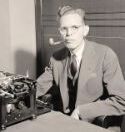Thanks to Louis and his generosity, I now have a big Verity's. I have a couple of the little guys, but this is my first large orbit fan. I ended up restoring it because it appeared to me to have been restored at some point. It was in pretty good condition aside from the paint and covered in a thick layer of deposits of some kind. Under the crust, the chrome looks nearly new, so nothing has bee rechromed, included the screws. The rubber feet and grommets were nice enough to re-use after soaking in AFT overnight to soften them. A note of caution for anyone going to restore one of these. The paint is near indestructible and withstood soaking in paint remover and my torch. Only soaking in lacquer thinner got it soft enough to remove with a wire wheel. That was a whole day stripping paint. I manage to nail the color with powder coat from Prismatic Powders, also. The speed label I made on my computer. It runs rather slow, I think, even though there is no drag on the parts, it ohms out OK and draws about 10% over the rated wattage. I think it's down to 50 vs 60 cycles. No worries, though, as 16 inch fans typically run too fast to use in my place.
So after it warmed up to a crisp 63 degrees this morning, I made a short video of it.
Cheers,
Bill

